Probabilistic Evaluation of the Multicategory Seasonal Precipitation Re-Forecast
Abstract
:1. Introduction
2. Model, Data, and Methods
2.1. Dynamical Seasonal Ensemble Forecast
2.2. Observation Data
2.3. Probabilistic Evaluation Method
2.4. Experiment Design for Seasonal and Intra-Seasonal Hindcasts
2.5. Confidence Interval
3. Results and Discussion
3.1. Probabilistic Evaluation of Seasonal Precipitation Hindcast
3.2. Reliability
3.3. Probabilistic Evaluation of the Intra-Seasonal Precipitation Hindcast
3.4. Quantification of Uncertainties by Confidence Intervals
4. Conclusions
Funding
Data Availability Statement
Acknowledgments
Conflicts of Interest
Appendix A
References
- Ceglar, A.; Toreti, A. Seasonal climate forecast can inform the European agricultural sector well in advance of harvesting. NPJ Clim. Atmos. Sci. 2021, 4, 42. [Google Scholar] [CrossRef]
- Miller, S.; Mishra, V.; Ellenburg, W.L.; Adams, E.; Roberts, J.; Limaye, A.; Griffin, R. Analysis of a short-term and a seasonal precipitation forecast over Kenya. Atmosphere 2021, 12, 1371. [Google Scholar] [CrossRef]
- Osgood, D.E.; Suarez, P.; Hansen, J.; Carriquiry, M.; Mishra, A. Integrating Seasonal Forecasts and Insurance for Adaptation among Subsistence Farmers: The Case of Malawi. In Policy Research Working Paper, No. 4651; World Bank: Washington, DC, USA, 2008. [Google Scholar]
- Daron, J.D.; Stainforth, D.A. Assessing pricing assumptions for weather index insurance in a changing climate. Clim. Risk Manag. 2014, 1, 76–91. [Google Scholar] [CrossRef] [Green Version]
- Kharin, V.V.; Boer, G.J.; Merryfield, W.J.; Scinocca, J.F.; Lee, W.S. Statistical adjustment of decadal predictions in a changing climate. Geophys. Res. Lett. 2012, 39, L19705. [Google Scholar] [CrossRef]
- Batte, L.; Dorel, L.; Ardilouze, C.; Gueremy, J.F. Documentation of the METEO-FRANCE Seasonal Forecasting System 7. 2019. Available online: 2018/C3S_330_Meteo-France/SC1 (accessed on 30 May 2022).
- Brier, G.W. Verification of forecasts expressed in terms of probability. Mon. Weather Rev. 1950, 78, 1–3. [Google Scholar] [CrossRef]
- Wilks, D. Statistical Methods in the Atmospheric Sciences; Academic Press: Cambridge, MA, USA, 2006; 627p. [Google Scholar]
- Murphy, A.H. A new vector partition of the probability score. J. Appl. Meteor. 1973, 12, 595–600. [Google Scholar] [CrossRef] [Green Version]
- Kharin, V.V.; Zwiers, F.W. Improved seasonal probability forecasts. J. Clim. 2003, 16, 1684–1701. [Google Scholar] [CrossRef]
- Tippett, M.; Barnston, A.G.; Robertson, A.W. Estimation of seasonal precipitation tercile-based categorical probabilities from ensembles. J. Clim. 2007, 20, 2210–2228. [Google Scholar] [CrossRef] [Green Version]
- Roeckner, E.; Arpe, K.; Bengtsson, L.; Christoph, M.; Claussen, M.; Dümenil, L.; Esch, M.; Giorgetta, M.; Schlese, U.; Schulzweida, U. The atmospheric general circulation model ECHAM-4: Model description and simulation of present-day climate. Max Planck Inst. Meteorol. Tech. Rep. 1996, 218, 90. [Google Scholar]
- Bradley, A.A.; Schwartz, S.S. Summary verification measures and their interpretation for ensemble forecasts. Mon. Wea. Rev. 2011, 78, 1–3. [Google Scholar] [CrossRef]
- Tippett, M.K.; Ranganathan, M.; Heureux, M.L.; Barston, A.G.; DelSole, T. Assessing probabilistic predictions of ENSO phase and intensity from the North American Multimodel Ensemble. Clim. Dyn. 2017, 53, 7497–7518. [Google Scholar] [CrossRef] [PubMed] [Green Version]
- Becker, A.; Van Den Dool, H. Probabilistic seasonal forecasts in the North America multimodel ensemble: A baseline skill assessment. J. Clim. 2016, 29, 3015–3026. [Google Scholar] [CrossRef]
- Weisheimer, A.; Palmer, T.N. On the reliability of seasonal climate forecasts. J. R. Soc. Interface 2014, 11, 20131162. [Google Scholar] [CrossRef] [PubMed]
- Brocker, J.; Smith, L.A. Increasing the reliability of reliability diagrams. Weather Forecast. 2007, 22, 651–661. [Google Scholar] [CrossRef]
- Hersbach, H. Decomposition of the continuous ranked probability score for ensemble prediction systems. Weather Forecast. 2000, 15, 559–570. [Google Scholar] [CrossRef]
- Wilks, D. Diagnostic verification of the climate prediction center long-lead outlooks. J. Climate 2000, 13, 2389–2403. [Google Scholar] [CrossRef]
- Johnson, S.J.; Stockdale, T.N.; Ferranti, L.; Balmaseda, M.A.; Molteni, F.; Magnusson, L.; Tietsche, S.; Decremer, D.; Weisheimer, A.; Balsamo, G.; et al. SEAS5: The new ECMWF seasonal forecast system. Geosci. Model Dev. 2019, 12, 1087–1117. [Google Scholar] [CrossRef] [Green Version]
- Stockdale, T.N.; Alves, O.; Boer, G.; Deque, M.; Ding, Y.; Kumar, A.; Kumar, K.; Landman, W.; Mason, S.; Nobre, P.; et al. Understanding and Predicting Seasonal-to-Interannual Climate Variability—The Producer Perspective. Procedia Environ. Sci. 2010, 1, 55–80. [Google Scholar] [CrossRef] [Green Version]
- Palmer, T.N. Extended-range atmospheric prediction and the Lorenz model. Bull. Am. Meteorol. Soc. 1993, 74, 49–65. [Google Scholar] [CrossRef] [Green Version]
- Lorenz, E.N. Deterministic nonperiodic flow. J. Atmos. Sci. 1963, 20, 130–141. [Google Scholar] [CrossRef] [Green Version]
- Slingo, J.; Palmer, T. Uncertainty in weather and climate prediction. Phil. Trans. R Soc. A 2011, 369, 4751–4757. [Google Scholar] [CrossRef] [PubMed]
- Barston, A.G.; Li, S.; Mason, S.J.; DeWitt, D.G.; Goddard, L.; Gong, X. Verification of the first 11 years of IRI’s seasonal climate forecast. J. App. Meteoro. Clim. 2010, 49, 493–520. [Google Scholar] [CrossRef]
- Lenssen, N.J.; Goddard, L.; Mason, S. Seasonal forecast skill of ENSO teleconnection maps. Weather Forecast. 2020, 35, 2387–2406. [Google Scholar] [CrossRef]
- Koster, R.D.; Suarez, M.J. Soil moisture memory in climate models. J. Hydrometeorol. 2001, 2, 558. [Google Scholar] [CrossRef]
- Seneviratne, S.I.; Koster, R.D.; Guo, Z.; Dirmeyer, P.A.; Kowalczyk, E.; Lawrence, D.; Liu, P.; Mocko, D.; Lu, C.H.; Oleson, K.W.; et al. Soil moisture memory in AGCM simulations: Analysis of Global Land–Atmosphere Coupling Experiment (GLACE) data. J. Hydrometeo. 2006, 7, 1090. [Google Scholar] [CrossRef] [Green Version]
- Esit, M.; Kumar, S.; Pandey, A.; Lawrence, D.M.; Rangwala, I.; Yeager, S. Seasonal to multi-year soil moisture drought forecasting. NPJ Clim. Atmos. Sci. 2021, 4, 16. [Google Scholar] [CrossRef]
- Zhang, C. Madden-Julian Oscillation. Rev. Geophys. 2005, 43, 1–36. [Google Scholar] [CrossRef] [Green Version]
- DeMotte, C.A.; Klingaman, N.P.; Woolnough, S.J. Atmosphere-ocean coupled processes in the madden Julian oscillation. Rev. Geophy. 2015, 53, 1099–1154. [Google Scholar] [CrossRef]
- Vigaud, N.; Robertson, A.W.; Tippett, M.K.; Acharya, N. Subseasonal predictability of boreal summer monsoon rainfall from ensemble forecasts. Front. Env. Sci 2017, 5, 67. [Google Scholar] [CrossRef] [Green Version]
- Vigaud, N.; Robertson, A.W.; Tippett, M.K. Multimodel Ensembling of subseasonal precipitation forecasts over North America. Mon. Wea Rev. 2017, 45, 3913–3928. [Google Scholar] [CrossRef]
- Voldoire, A.; Saint-Martin, D.; Sénési, S.; Decharme, B.; Alias, A.; Chevallier, M.; Colin, J.; Guérémy, J.; Michou, M.; Moine, M.; et al. Evaluation of CMIP6 DECK Experiments with CNRM-CM6-1. J. Adv. Model. Earth Syst. 2019, 11, 2177–2221. [Google Scholar] [CrossRef] [Green Version]
- Larson, J.; Jacob, R.; Ong, E. The model coupling toolkit: A new Fortran90 toolkit for building Multiphysics parallel coupled models. Inter. J. High Perform. Comput. Appl. 2005, 19, 277–292. [Google Scholar] [CrossRef]
- Déqué, M.; Reveton, C.; Braun, A.; Cariolle, D. The ARPEGE/IFS atmosphere model: A contribution to the French comunitu climate modelling. Clim. Dyn. 1994, 10, 249–266. [Google Scholar] [CrossRef]
- Noilhan, J.; Planton, S. A simple parameterization of land surface processes for meteorological models. Mon. Weather Rev. 1989, 117, 536–549. [Google Scholar] [CrossRef]
- Voldoire, A.; Decharme, B.; Pianezze, J.; Brossier, C.L.; Sevault, F.; Seyfried, L.; Garnier, V.; Bielli, S.; Valcke, S.; Alias, A.; et al. SURFEX v8.0 interface with OASIS3-MCT to couple atmosphere with hydrology, ocean, waves and sea-ice models, from coastal to global scales. Geosci. Model Dev. 2017, 10, 4207–4227. [Google Scholar] [CrossRef] [Green Version]
- Decharme, B.; Delire, C.; Minvielle, M.; Colin, J.; Vergnes, J.-P.; Alias, A.; Saint-Martin, D.; Séférian, R.; Sénési, S.; Voldoire, A. Recent Changes in the ISBA-CTRIP Land Surface System for Use in the CNRM-CM6 Climate Model and in Global Off-Line Hydrological Applications. J. Adv. Model. Earth Syst. 2019, 11, 1207–1252. [Google Scholar] [CrossRef]
- Madec, G.; The NEMO Team. NEMO Ocean Engine (V3.6); Scientific Notes of Climate Modelling Center, Institute Pierre-Simon Laplace (IPSL): Guyancourt, France, 2016; ISSN 1288-1619. [Google Scholar]
- Salas y Mélia, D. A global coupled sea ice-ocean model. Ocean. Model 2002, 4, 137–172. [Google Scholar] [CrossRef]
- Batte, L.; Deque, M. Randomly correcting model errors in the ARPEGE-Climate v6.1 component of CNRM-CM: Application for seasonal forecasts. Geosci. Model Dev. 2016, 9, 2055–2076. [Google Scholar] [CrossRef] [Green Version]
- Boisserie, M.; Decharme, B.; Descamps, L.; Arbogast, P. Land surface initialization strategy for a global re-forecast dataset. Q. J. Roy. Meteor. Soc. 2016, 142, 880–888. [Google Scholar] [CrossRef] [Green Version]
- Dubois, C.; Mercator-Ocean, Toulouse, France. Initial Condition from Mercator-Ocean. Personal communication, 2016. [Google Scholar]
- Adler, R.F.; Huffman, G.J.; Chang, A.; Ferraro, R.; Xie, P.P.; Janowiak, J.; Rudolf, B.; Schneider, U.; Curtis, S.; Bolvin, D.; et al. The Version-2 Global Precipitation Climatology Project (GPCP) Monthly Precipitation Analysis (1979–Present). J. Hydrometeorol. 2003, 4, 1147–1167. [Google Scholar] [CrossRef]
- Beck, H.E.; van Dijk, A.I.J.M.; Levizzani, V.; Shellekens, J.; Miralles, D.G.; Martens, B.; de Roo, A. MSWEP: 3-hourly 0.25 global grided precipitation (1979–2015) by merging gauge, satellite, and reanalysis data. Hydrol. Earth Syst. Sci. 2017, 21, 589–615. [Google Scholar] [CrossRef] [Green Version]
- Manubens, N.; Caron, L.-P.; Hunter, A.; Bellprat, O.; Exarchou, E.; Fučkar, N.S.; García-Serrano, J.; Massonnet, F.; Ménégoz, M.; Sicardi, V.; et al. An R package for climate forecast verification. Environ. Model. Softw. 2018, 103, 29–42. [Google Scholar] [CrossRef]
- Specq, D.; Batte, L. Improving subseasonal precipitation forecasts through a statistical-dynamical approach: Application to the southwest tropical Pacific. Clim. Dyn. 2020, 55, 1913–1927. [Google Scholar] [CrossRef]
- Efron, B. Better Bootstrap Confidence Intervals; Technical Report, No. 14; Stanford University: Stanford, CA, USA, 1984. [Google Scholar]
- Pathak, P.K. Sufficiency in sampling theory. Ann. Math Stat. 1964, M43, 508–515. [Google Scholar] [CrossRef]
- Pathak, P.K.; Rao, C.R. The Sequential Bootstrap. Handb. Stat. 2013, 31, 2–18. [Google Scholar] [CrossRef]
- Bradley, A.; Schwartz, S.S.; Hasino, T. Sampling uncertainty and confidence intervals for the Briere score and Brier skill score. Weather Forecast. 2008, 23, 992–1006. [Google Scholar] [CrossRef]
- Murphy, A.H.; Winkler, R.L. Diagnostic verification of probability forecasts. Int. J. Forecast. 1992, 7, 435–455. [Google Scholar] [CrossRef]
- Hermanson, L.; Ren, H.L.; Velligna, M.; Dunstone, N.D.; Hyder, P.; Ineson, S.; Scaife, A.A.; Smith, D.M.; Thomson, V.; Tian, B.; et al. Different types of drifts in two seasonal forecast systems and their dependence on ENSO. Clim. Dyn. 2018, 51, 1411–1426. [Google Scholar] [CrossRef] [Green Version]
- Attada, R.; Dasari, H.P.; Parekh, A.; Chowdary, J.S.; Langodan, S.; Knio, O.; Hoteit, I. The role of the Indian summer monsoon variability on Arabian Peninsula summer climate. Clim. Dyn. 2018, 52, 3389–3404. [Google Scholar] [CrossRef]
- Chakraborty, A.; Behera, S.K.; Mujumdar, M.; Ohba, R.; Yamagata, T. Diagnosis of tropospheric moisture over Saudi Arabia and influences of IOD and ENSO. Mon. Weather Rev. 2006, 134, 598–617. [Google Scholar] [CrossRef]
- Almazroui, M. Sensitivity of a regional climate model on the simulation of high intensity rainfall events over the Arabian Peninsula and around Jeddah (Saudi Arabia). Theor. Appl. Climatol. 2011, 104, 261–276. [Google Scholar] [CrossRef] [Green Version]
- Xu, Y. Global Root Zone Soil Moisture: Assimilation and Impact; CNRM, Meteo-France: Toulouse, France, 2022; (To be submitted). [Google Scholar]
- Juarez, R.I.N.; Li, W.; Fu, R.; Fernandes, K.; Cardoso, A.D.O. Comparison of Precipitation Datasets over the Tropical South American and African Continents. J. Hydrometeorol. 2009, 10, 289–299. [Google Scholar] [CrossRef]
- Telcik, N.; Pattiaratch, C. Influence of Northwest Cloudbands on Southwest Australian Rainfall. J. Climatol. 2014, 2014, 671394. [Google Scholar] [CrossRef] [Green Version]
- Reid, K.J.; Simmonds, I.; Vincent, C.; King, A.D. The Australia northwest cloudband: Climatology, mechanisms, and association with precipitation. J. Clim. 2019, 32, 6665–6684. [Google Scholar] [CrossRef]
- Specq, D.; Batte, L.; Deque, M.; Ardilouze, C. Multimodel forecasting of precipitation at subseasonal timescales over the Southwest tropical Pacific. Earth Space Sci. 2020, 7, e2019EA001003. [Google Scholar] [CrossRef]
- Andrade, F.M.D.; Coelho, C.A.S.; Cavalcanti, I.F.A. Global precipitation hindcast quality assessment of the subseasonal to seasonal (S2S) prediction project models. Clim. Dyn. 2018, 52, 5451–5475. [Google Scholar] [CrossRef]
- Yun, K.-S.; Lee, J.-Y.; Timmermann, A.; Stein, K.; Stuecker, M.F.; Fyfe, J.C.; Chung, E.-S. Increasing ENSO–rainfall variability due to changes in future tropical temperature–rainfall relationship. Commun. Earth Environ. 2021, 2, 43. [Google Scholar] [CrossRef]
- Recalde-Coronel, G.C.; Zaitchik, B.; Pan, W.K.Y. Madden-Julian Oscillation influence on sub-seasonal rainfall variability on the west of South America. Clim. Dyn. 2020, 54, 2167–2185. [Google Scholar] [CrossRef]
- Sabin, T.P.; Babu, C.A.; Joseph, P.V. SST-convection relationship over tropical oceans. Int. J. Climatol. 2012, 33, 1424–1435. [Google Scholar] [CrossRef] [Green Version]
- Good, P.; Chadwick, R.; Holloway, C.E.; Kennedy, J.; Lowe, J.A.; Roehig, R.; Rushley, S.S. High sensitivity of tropical precipitation to local sea surface temperature. Nature 2020, 589, 408–414. [Google Scholar] [CrossRef]
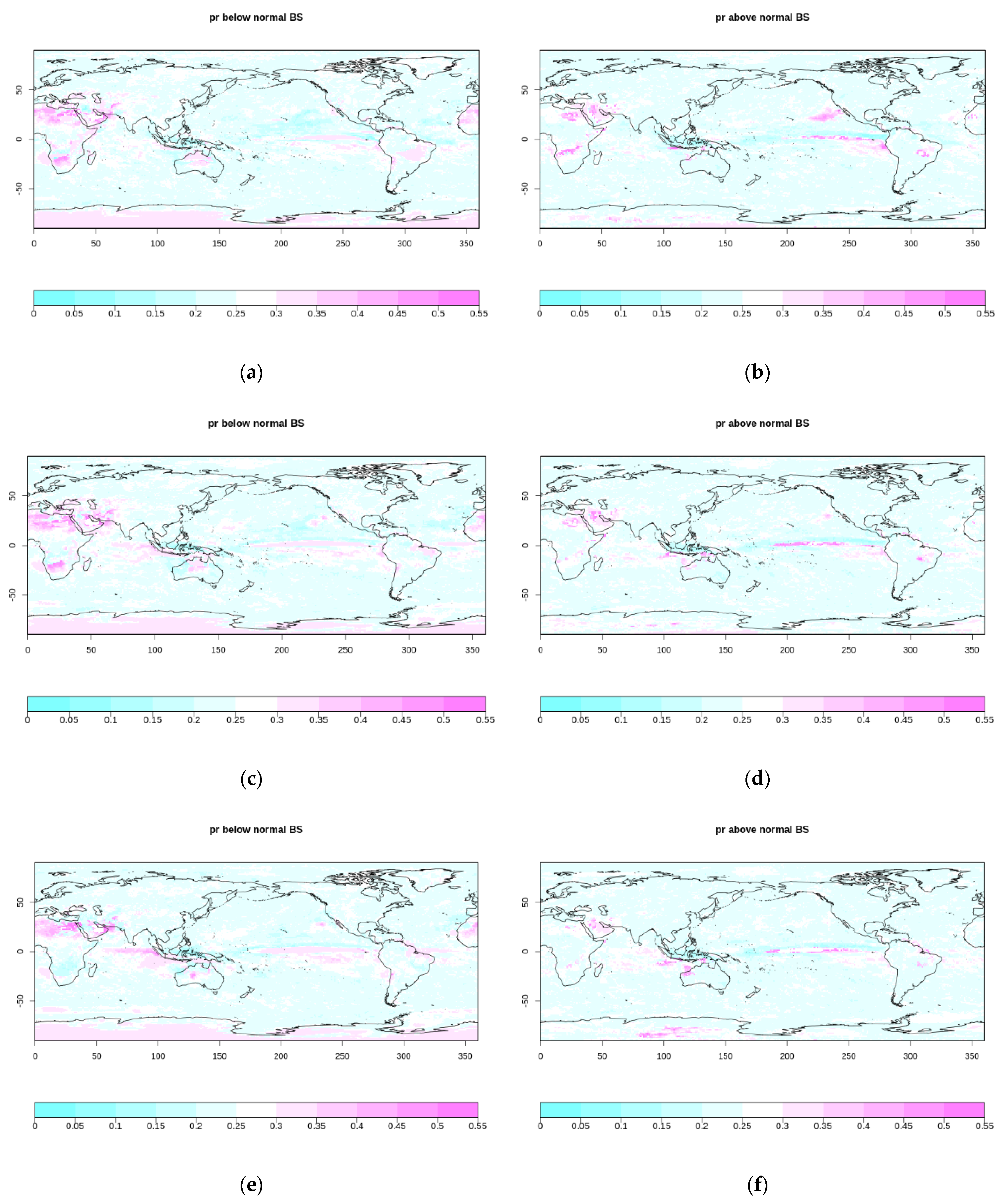
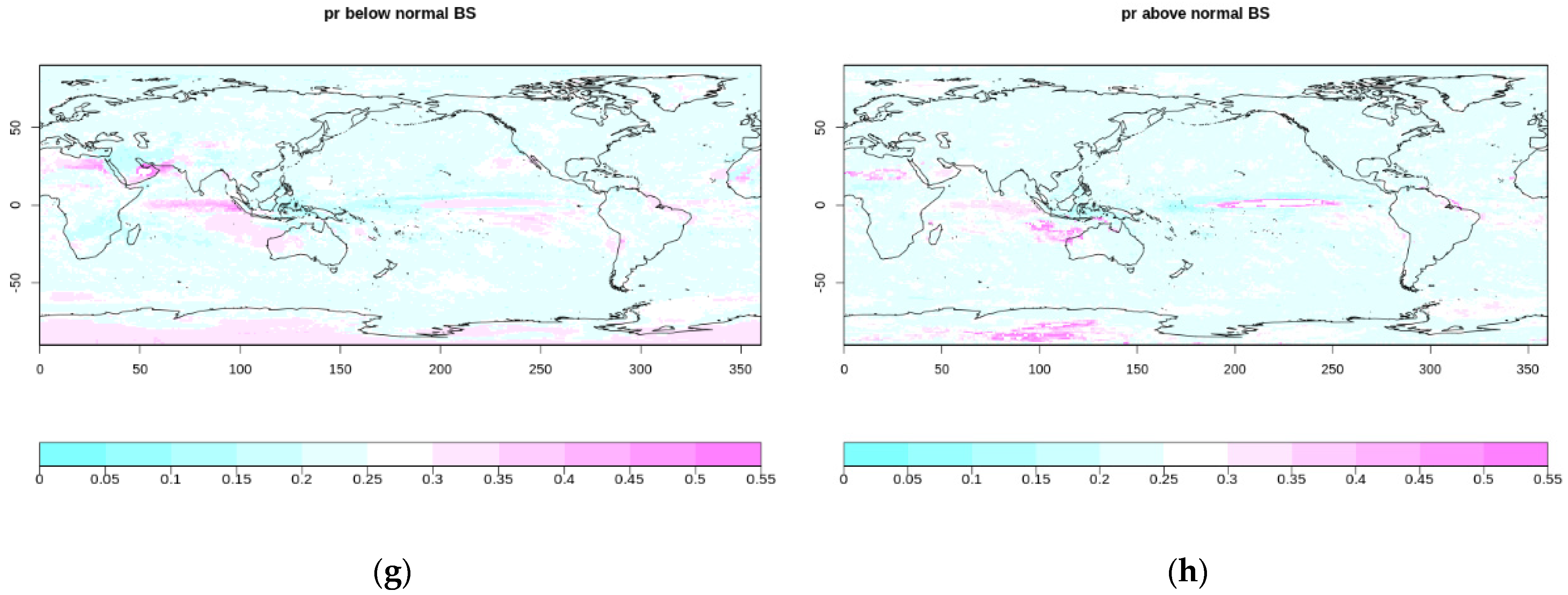
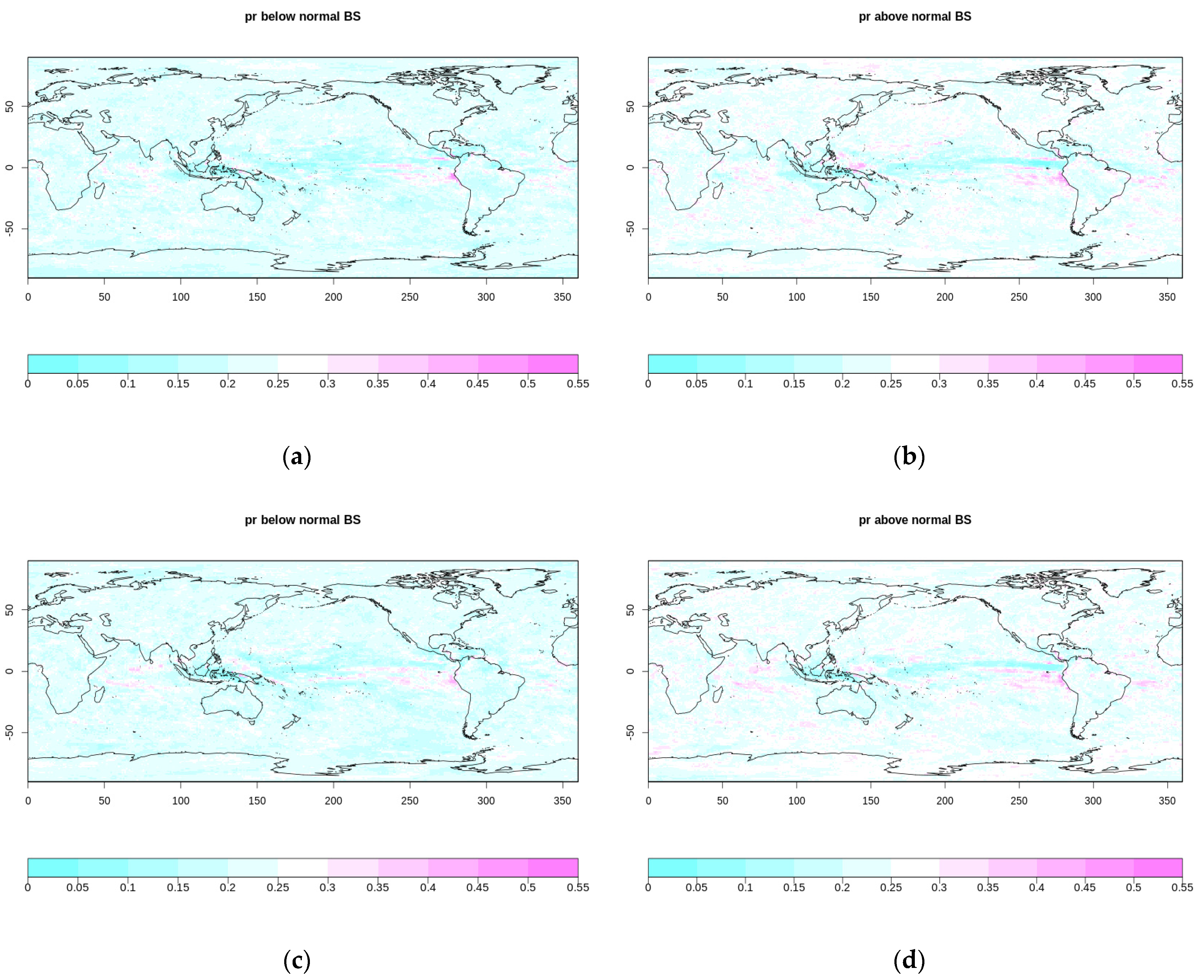

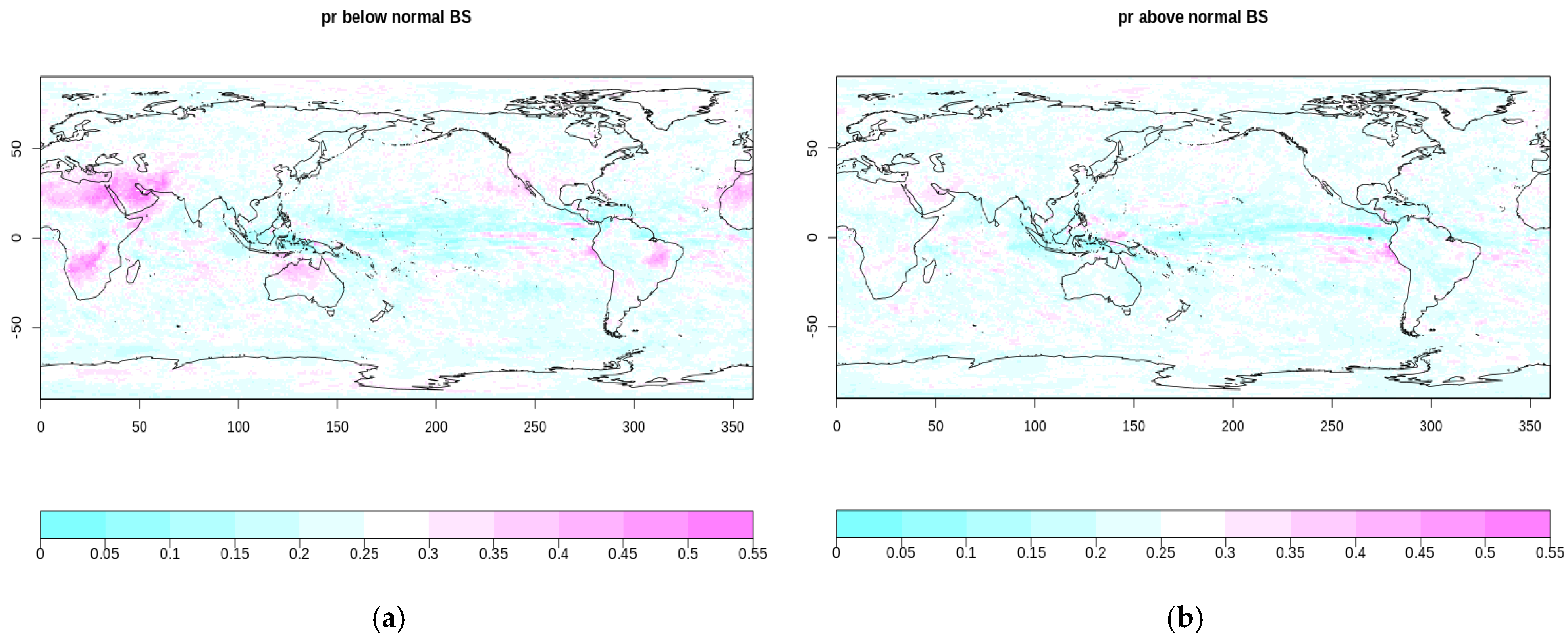
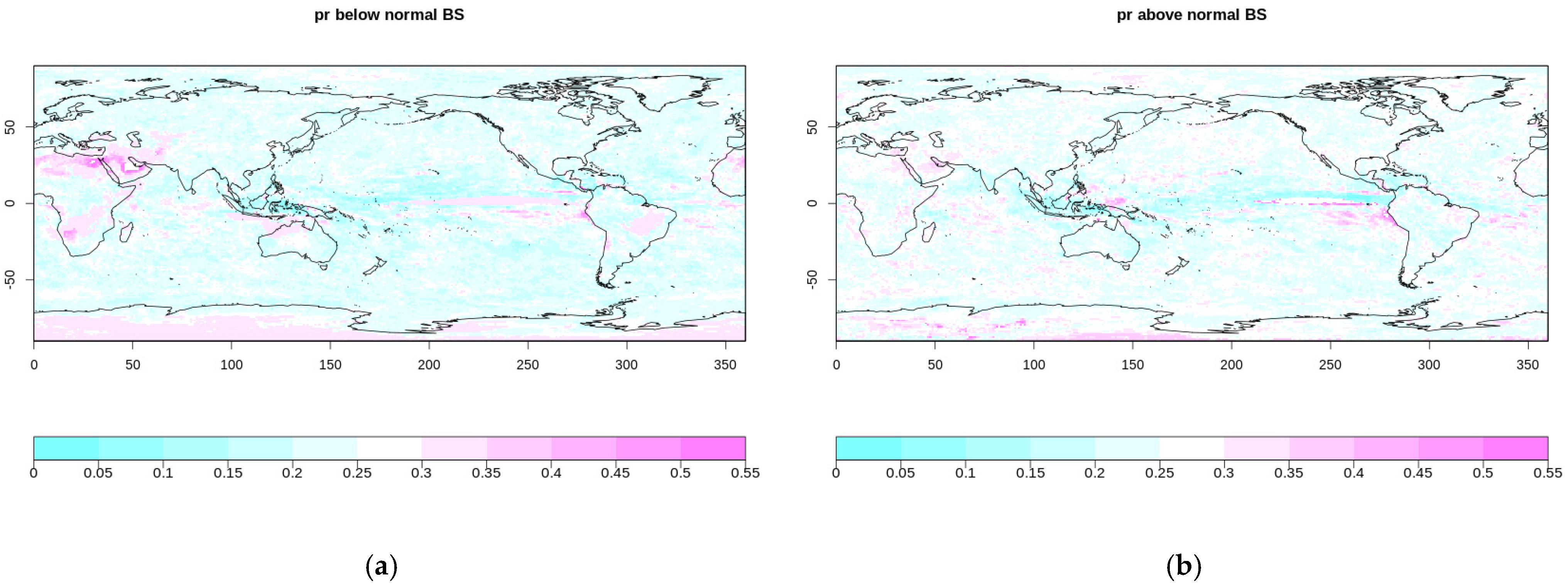

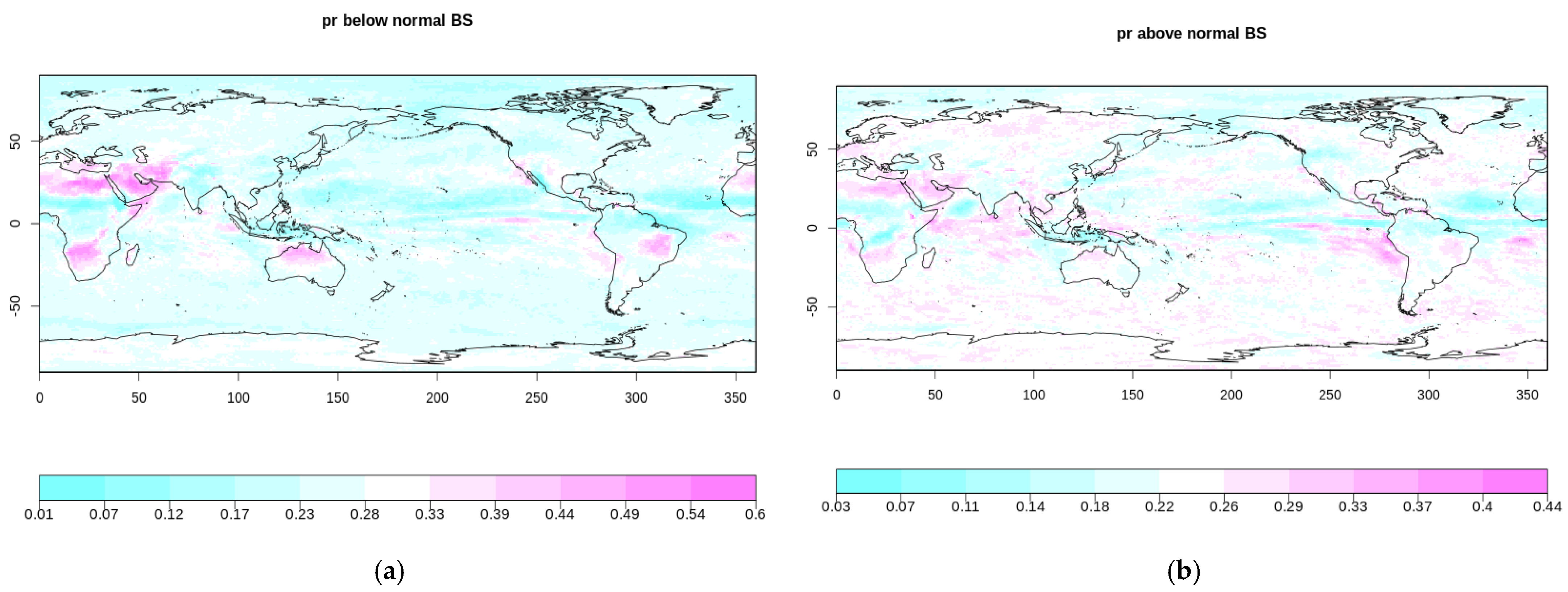
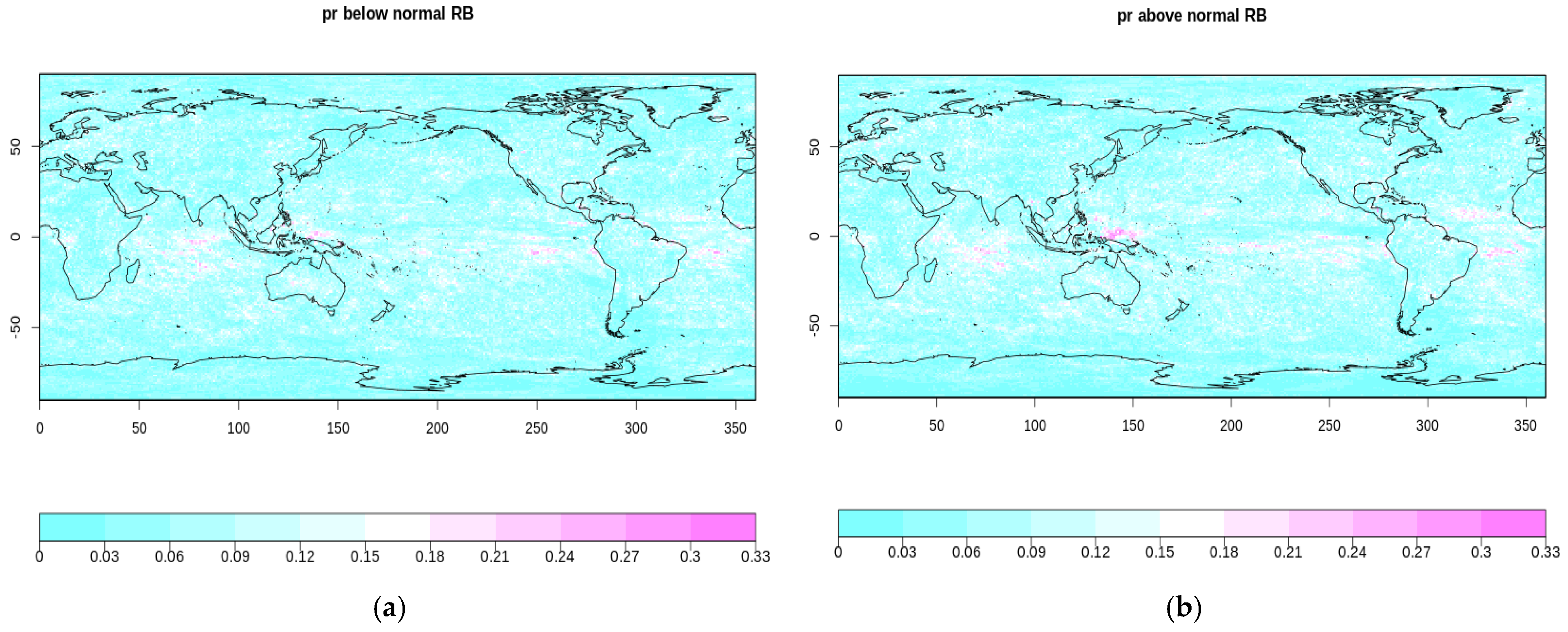
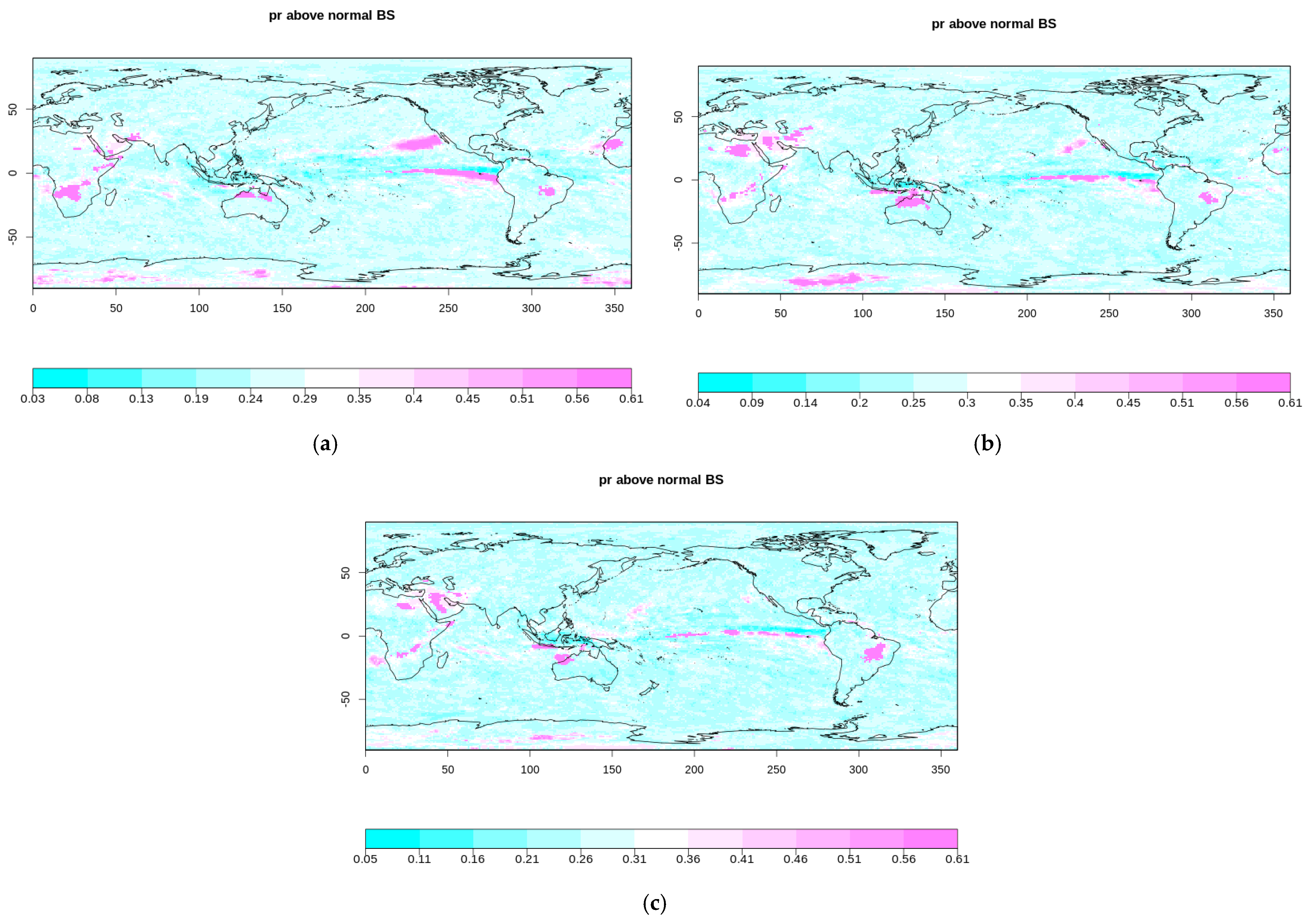
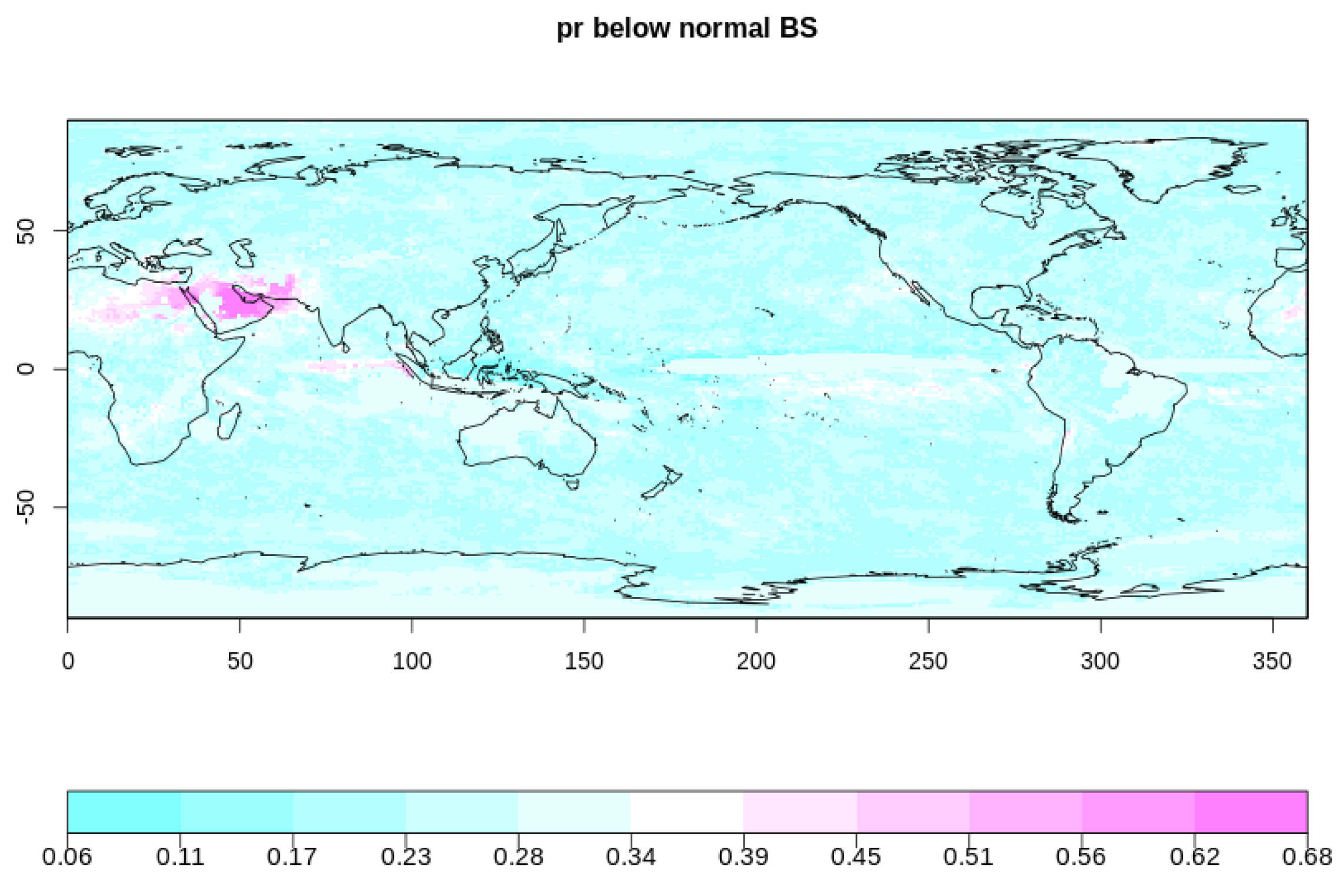
| Method 1 | Method 2, 3, and 4 | Method 5 | Method 6 | ||
|---|---|---|---|---|---|
| Samples | 3-months precipitation anomalies | 3-months mean precipitation | 3-months mean precipitation | 3-months precipitation anomalies | |
| Initialization | May | May | May | mixed months | |
| Ensemble Members | 25 | 25 | 25 | 7 | |
| Reference Data | GPCP | GPCP | GPCP MSWEP | GPCP | |
| Sets of Terciles | 1 | 2 | 1 for Method 4 | 2 | 2 |
| Tercile Threshold for Observation | GPCP climatology | GPCP climatology | GPCP MSWEP ensemble climatology | GPCP climatology | |
| Tercile Threshold for Hindcast | GPCP climatology | ensemble climatology/mean climatology for Method 2/3 | GPCP climatology for Method 4 | ensemble climatology | ensemble mean climatology |
| resampling | ||||||
| TerB | forecast mean | bootstrap | CI95% LB | CI95% UB | CI95% | % |
| Method 2 | 0.2122 | 0.2242 | 0.1808 | 0.2656 | 0.0848 | 39.96% |
| Method 5 | 0.1398 | 0.1517 | 0.1174 | 0.185 | 0.0676 | 48.35% |
| TerA | ||||||
| Method 2 | 0.2356 | 0.248 | 0.2021 | 0.2915 | 0.0894 | 37.95% |
| Method 5 | 0.1521 | 0.1644 | 0.1283 | 0.1992 | 0.0709 | 46.61% |
| method of moments | ||||||
| TerB | forecast mean | CI95% LB | CI95% UB | CI95% | % | |
| Method 1 | 0.25 | 0.2423 | 0.2578 | 0.0155 | 6.20% | |
| Method 2 | 0.2122 | 0.1914 | 0.233 | 0.0416 | 19.60% | |
| Method 3 | 0.2523 | 0.2339 | 0.2708 | 0.0369 | 14.63% | |
| TerA | ||||||
| Method 1 | 0.2451 | 0.2377 | 0.2526 | 0.0149 | 6.08% | |
| Method 2 | 0.2356 | 0.2146 | 0.2566 | 0.042 | 17.83% | |
| Method 3 | 0.2374 | 0.2168 | 0.258 | 0.0412 | 17.35% | |
| TerB | Forecast Mean | CI95% LB | CI95% UB | CI95% | % |
|---|---|---|---|---|---|
| MJJ | 0.2018 | 0.1811 | 0.2224 | 0.0413 | 20.46% |
| JJA | 0.2122 | 0.1914 | 0.233 | 0.0416 | 19.60% |
| JAS | 0.216 | 0.1953 | 0.2366 | 0.0413 | 19.12% |
| ASO | 0.2168 | 0.1967 | 0.2369 | 0.0402 | 18.54% |
| SON | 0.2132 | 0.1939 | 0.2326 | 0.0387 | 18.15% |
| TerA | |||||
| MJJ | 0.225 | 0.2033 | 0.2468 | 0.0435 | 19.33% |
| JJA | 0.2356 | 0.2146 | 0.2566 | 0.042 | 17.83% |
| JAS | 0.2399 | 0.219 | 0.2609 | 0.0419 | 17.47% |
| ASO | 0.2415 | 0.2211 | 0.2619 | 0.0408 | 16.89% |
| SON | 0.239 | 0.2194 | 0.2586 | 0.0392 | 16.40% |
Publisher’s Note: MDPI stays neutral with regard to jurisdictional claims in published maps and institutional affiliations. |
© 2022 by the author. Licensee MDPI, Basel, Switzerland. This article is an open access article distributed under the terms and conditions of the Creative Commons Attribution (CC BY) license (https://creativecommons.org/licenses/by/4.0/).
Share and Cite
Xu, Y. Probabilistic Evaluation of the Multicategory Seasonal Precipitation Re-Forecast. Meteorology 2022, 1, 231-253. https://doi.org/10.3390/meteorology1030016
Xu Y. Probabilistic Evaluation of the Multicategory Seasonal Precipitation Re-Forecast. Meteorology. 2022; 1(3):231-253. https://doi.org/10.3390/meteorology1030016
Chicago/Turabian StyleXu, Yiwen. 2022. "Probabilistic Evaluation of the Multicategory Seasonal Precipitation Re-Forecast" Meteorology 1, no. 3: 231-253. https://doi.org/10.3390/meteorology1030016
APA StyleXu, Y. (2022). Probabilistic Evaluation of the Multicategory Seasonal Precipitation Re-Forecast. Meteorology, 1(3), 231-253. https://doi.org/10.3390/meteorology1030016





